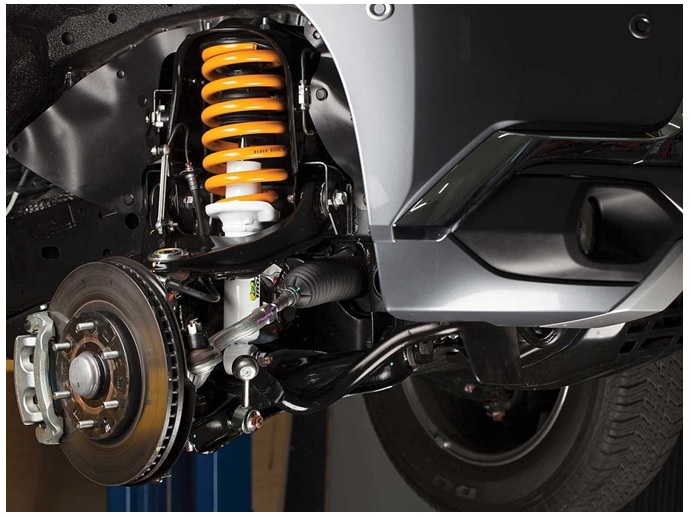Ever wondered what exactly keeps your high-performance, four-wheel drive vehicle from shaking and rattling itself apart on rough trails? Ever marvelled at the unseen artistry that allows these four-wheeled miracles to ascend daunting inclines or conquer rocky terrains with astounding grace and rugged elegance? Well, there’s a secret marvel we tend to overlook: the marvel that is the 4×4 suspension system.
This unsung hero of off-road mastery does not receive the admiration it truly deserves. Hidden beneath the body of your tough-as-nails vehicle, it’s a kinetic marvel of engineered beauty, tirelessly absorbing shock and reducing impact, while maintaining tire/alien contact to ensure grip where it counts most.
In this primer, we’ll peel back the shielded underbelly of your 4×4 to expose and explore the intricate mechanics of the 4×4 suspension system, looking into its core, intricate interplay of components, and how they all come together to bless us with that soothing, assuring ride even in the roughest terrains.
The Artistry and Science Behind The 4×4 Suspension System
Consider a ballet dancer taking a challenging pirouette. It’s an interplay of swift, fluid movements, control, counterbalance, and tireless practice, all contributing to a breathtaking performance. Much like that dancer, a 4×4’s suspension is a high-stakes performance of metal, engineering, and sheer vehicular ballet.
A four-wheel suspension system is a complex blend of components, including springs, dampers, anti-sway bars, suspension arms and more. Each piece of this ensemble has a crucial role to play, all working together in harmony to cushion blows, mitigate vibration, maintain tire-to-ground contact and ensure your vehicle’s optimal control and safety.
Let’s now take a deeper dip into the cascade of components that make up this awe-inspiring system.
A Cascade of Components
At the core, you have the springs absorbing road bumps, every bit as crucial as the pointe shoes to the ballet dancer. They cushion the vehicle’s body from the undulations of the road, easing you into what otherwise would be a bone-jarring ride.
Next in the line-up is the shock absorber, or damper, a companion to the spring, its performance partner if you like. This component rapidly dissipates the energy absorbed by the spring, thus damping the oscillation triggered by the obstacles.
Additional components like the anti-sway bar and the linkage play their critical roles too, further enhancing stability and control.
The Types of Suspension Systems in Play
Now, these components can be assembled into different types of suspension systems, each with its strengths and weaknesses. The two most common systems employed by 4×4 vehicles are the solid axle and the independent suspension.
The solid axle design, with its robust simplicity and durability, is a favourite among hard-core off-roaders. On the other side, the independent suspension – which allows each wheel to move independently – provides a smoother and more comfortable ride, making it preferred for SUVs and lighter duty 4x4s.
The types of suspension systems in play for 4×4 vehicles include solid axle, independent, and air suspensions. Solid axle systems are durable and provide excellent off-road capability, while independent suspensions offer a smoother ride and better handling. Air suspensions allow for adjustable ride height and improved comfort on various terrains.
Why Should We Know This Anyway?
You might wonder, what’s the value in understanding this complex ensemble that’s hidden beneath your vehicle? You’re not the mechanic, after all. While that might be true, knowledge is power. Understanding the mechanics of your 4×4’s suspension system could help you make informed decisions about maintenance, upgrades and even driving techniques!
Understanding 4×4 suspension systems is essential for off-road enthusiasts and anyone interested in vehicle mechanics. It allows you to appreciate how these systems enhance performance, safety, and comfort on rough terrains. Knowing the mechanics can also aid in making informed decisions when purchasing or modifying a 4×4 vehicle.
The Graceful Balance of Pros and Cons
Undoubtedly, the 4×4 suspension system brings a wealth of benefits – road shock absorption, enhancing comfort, safety, and vehicle control. However, it’s not without its flip side. Upgrades can be costly, maintenance can be time-consuming, but that’s a small price to pay for a smoother, safer journey.
The graceful balance of pros and cons involves weighing the advantages and disadvantages to make informed decisions. By evaluating both sides, you can achieve a more comprehensive understanding and find solutions that best meet your needs. This balanced approach fosters better decision-making and improved outcomes.
Conclusion: The Unseen Hero of the 4×4 Experience
In conclusion, next time you marvel at the commendable poise with which your 4×4 conquers that incline, remember to toast to the unseen hero beneath your vehicle. The 4×4 suspension system, with its intricate interplay of mechanical ballet dancers, is as deserving of your applause as any other part of your off-road beast. It’s not just about the destination, it’s also about the difference a well-tuned suspension system can make to your journey!
The unseen hero of the 4×4 experience is the advanced suspension system. This crucial component ensures stability, comfort, and superior off-road performance. By providing better traction and control on challenging terrains, the suspension system makes every adventure safer and more enjoyable, showcasing its vital yet often overlooked role.











